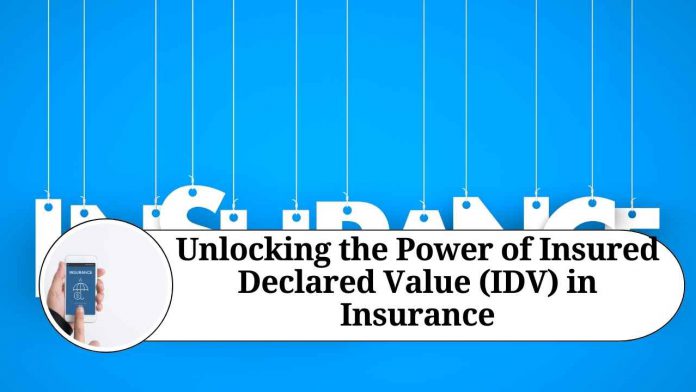Introduction
When it comes to protecting our valuable assets, such as our vehicles, insurance plays a crucial role in providing financial security and peace of mind. Insured Declared Value (IDV) is a key concept in the world of insurance, particularly in motor insurance. Understanding IDV and its significance can empower policyholders to make informed decisions and ensure they receive adequate compensation in the event of a loss. In this blog post, we will delve into the world of IDV in insurance and explore its importance.
What is Insured Declared Value (IDV)?
Insured Declared Value (IDV) is the maximum sum insured by an insurance company under a motor insurance policy. It represents the approximate market value of the insured vehicle. IDV serves as the basis for determining the premium amount and the claim settlement in case of theft or total loss of the vehicle due to an accident.
The Calculation Process:
The IDV of a vehicle is calculated based on factors such as the manufacturer’s listed selling price, the age of the vehicle, depreciation, and the vehicle’s model. Depreciation is a significant aspect of IDV calculation, as it considers the wear and tear the vehicle has undergone over time.
Importance of IDV:
- Accurate Premium Calculation: IDV directly affects the premium amount of your motor insurance policy. A higher IDV leads to a higher premium, as it signifies a greater coverage amount. Conversely, a lower IDV may result in a lower premium, but it also means a reduced coverage amount. Understanding the relationship between IDV and premium enables policyholders to choose the right coverage based on their needs and budget.
- Proper Compensation in Case of Total Loss: In the unfortunate event of a total loss or theft of your vehicle, the IDV determines the amount of compensation you receive from the insurance company. Having an accurate IDV ensures that you are adequately reimbursed, helping you to recover from the financial setback.
- Negotiating Power: When renewing your motor insurance policy, understanding the IDV can give you an edge while negotiating the premium amount. Being aware of the fair market value of your vehicle can help you assess the IDV offered by the insurer and negotiate for a more reasonable valuation, ensuring you get the best value for your money.
- Age Depreciation: As a vehicle ages, its value depreciates. IDV takes into account this depreciation, ensuring that you are not overpaying for an older vehicle’s coverage. It helps maintain a balance between the market value and the insurance coverage, preventing any potential disputes during claim settlement.
Tips for Maximizing IDV Benefits:
- Stay Updated: As a vehicle owner, it is essential to stay updated with the current market value of your vehicle. Regular research and keeping track of resale values can help you estimate a fair IDV for your motor insurance policy.
- Opt for Add-Ons: While IDV determines the coverage amount for your vehicle, it is advisable to opt for add-on covers like zero depreciation or engine protection. These add-ons enhance the coverage and ensure that you receive a higher compensation amount in case of damages.
- Timely Policy Renewals: Maintaining a continuous motor insurance policy and renewing it on time ensures that your IDV remains relevant and reflective of the current market value of your vehicle. A lapsed policy may result in re-evaluation and potential complications during the claim settlement process.
Conclusion
Insured Declared Value (IDV) is a vital component of motor insurance policies, providing an approximate market value for insured vehicles. Understanding IDV empowers policyholders to make informed decisions while choosing coverage and negotiating premiums.
Other Related Blogs: Section 144B Income Tax Act
Frequently Asked Questions (FAQs)
Q: What is Insured Declared Value (IDV)?
A: Insured Declared Value (IDV) is the maximum sum insured by an insurance company under a motor insurance policy. It represents the approximate market value of the insured vehicle and serves as the basis for determining the premium amount and claim settlement in case of theft or total loss of the vehicle due to an accident.
Q: How is IDV calculated?
A: IDV is calculated based on factors such as the manufacturer’s listed selling price, the age of the vehicle, depreciation, and the vehicle’s model. Depreciation is a significant aspect of IDV calculation as it considers the wear and tear the vehicle has undergone over time.
Q: Why is IDV important?
A: IDV is important for several reasons. It helps in determining the premium amount, ensuring that policyholders have the right coverage based on their needs and budget. In case of a total loss or theft, IDV determines the compensation amount, providing proper financial reimbursement. Additionally, understanding IDV gives policyholders negotiating power during policy renewals and helps maintain a fair balance between the market value and insurance coverage.
Q: Can I negotiate the IDV offered by the insurer?
A: Yes, you can negotiate the IDV offered by the insurer. Being aware of the fair market value of your vehicle can help you assess the IDV offered and negotiate for a more reasonable valuation. However, it’s important to provide supporting documents and evidence to justify your requested IDV.
Q: Does IDV remain the same throughout the policy term?
A: No, IDV does not remain the same throughout the policy term. It is usually adjusted at the time of policy renewal based on the vehicle’s age and depreciation. As the vehicle gets older, the IDV decreases to reflect its reduced market value.
Q: Are there any benefits to maximizing IDV?
A: Maximizing IDV can have benefits. A higher IDV ensures a higher coverage amount, providing better protection for your vehicle. In case of a total loss, you will receive a higher compensation amount. However, it’s important to balance the IDV with the premium amount to ensure affordability.
Q: How can I maximize IDV benefits?
A: To maximize IDV benefits, stay updated with the current market value of your vehicle, opt for add-on covers such as zero depreciation or engine protection, and maintain a continuous motor insurance policy with timely renewals. These steps help ensure that your IDV remains relevant and reflective of the vehicle’s current market value.
Q: Can IDV be higher than the vehicle’s purchase price?
A: No, IDV cannot be higher than the vehicle’s purchase price. IDV represents the approximate market value of the vehicle and is determined based on various factors, including depreciation. It aims to provide an accurate assessment of the vehicle’s value at a given point in time.
Q: Can I change the IDV during the policy term?
A: In most cases, you cannot change the IDV during the policy term. However, at the time of policy renewal, you can request a re-evaluation of the IDV based on the vehicle’s current market value. The insurance company will consider the request and adjust the IDV accordingly if deemed appropriate.




















